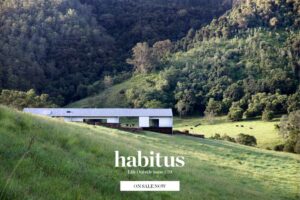Built three years after the completion of his own Kilara house, the Gissing House project was born of a request from Penelope and John Gissing to create a similar home for them.
The result was a design that maintained many of the material, geometric and circulatory elements of the previous project while re-dimensioning them to create a more intimate home on a more human scale.
Seidler’s regularity as an architect is evident in the use of blue-grey basalt rubble walls, grey concrete block blade walls and U-shaped stiffened floor plates, which as Philip Drew (co-author of Seidler’s definitive biography) states, “are all manifestations of Seidler’s consistent application of an underlying Modernist ideology”. Direct material continuity from the previous project sees the reuse of white concrete walls, oiled Tasmanian Oak planks for the ceiling and slate tiles across the floor, which not only give the interior a clean yet textured finish, but have aged with grace.
The structure rests in the centre of a large irregular plot bordered by neighbouring properties and leaves a generous surrounding swathe of landscaped areas. Looking beyond the boundaries of the lot Seidler situated the living areas at the northern end of the home, allowing sunlight to penetrate towards the rear of the structure. The inclined roof and raised height from south to north further reinforce the sense that the home opens as it approaches the sun.
Like in the Kilara House, Seidler employed a central void to amplify communal space and link separate levels. Narrow blade walls intersect the volume while projecting views from the back of the house towards the front windows. The house also manifests Seidler’s fascination with the use of circular geometry to offset and interrupt rectangular or straight lines. This both softens and details surfaces, piquing the observer’s curiosity and adding an organic twist to the aesthetic.
As Drew concludes, Seidler’s style of this period is particularly important because it marks the creation of a ‘Pacific type’: “durable, open and sheltering and connected to its landscape surrounds … [which] projects itself outwards, while simultaneously on the inside, reflecting in its dynamic openness, the Pacific culture that brought it into being.”
Gissing House is currently for sale, for more information visit modernhouse.co.
Contemporary Photography: Chris Colls
Original Photography: Max Dupain



















